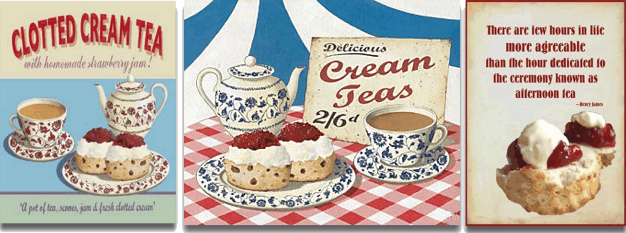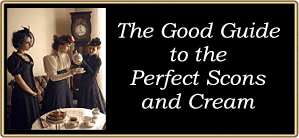
I wonder how many people reading this page have gone for a trip up to Dartmoor and rounded the day in search (and consumption) of a traditional Devon Cream Tea? I must confess I am not one that normally will tuck into a warm scon, cream and jam but when I have it has been following a visit to some attraction such as Lydford Gorge or the Finch Foundry. This meal seems to have become part of a Devonshire ritual which tends to take place after such visits or experiences. I suppose the Devon Cream Tea serves several purposes; firstly to fill a hunger gap, secondly it’s a chance to reflect on what the visit or experience has been like and lastly, it’s the done thing. But where and when did the Devon Cream Tea first make an appearance? Recent research has suggested that was a lot earlier than one might think.
If you like fairy tales then the Devonshire Cream Tea originally came from an ancient recipe given to a Giant’s wife by a Phoenician tin trader – see HERE. On the other hand if you prefer fact to fiction then read on and maybe even get a few surprises.
A traditional Devon cream tea consists today of scons, strawberry jam and clotted cream along with a strong, sugarless cup of tea. However, there is documentary evidence showing that the origins of this treat began life in Tavistock. During the renovation of Tavistock Abbey in the eleventh century the monks fed the labourers with bread, jam and clotted cream which could be argued was the forerunner of the cream tea. To this day many Dartmoor homes serve this up for Sunday afternoon tea as I can testify.
In 1860 an article in the National Magazine recounted a visit to Dartmoor; “A Devonshire dairy is soon seen, and, like all other important processes, the art of making Devonshire cream is a very simple affair… It is as mysterious a compound as “fine old port,” or “sparkling champagne;”… That is is agreeable to the palate, that it goes down softly, that with junkets, or fruit, or bread, or in tea, or simply by itself, it is a dish fit for the gods… It is altogether a produce of the soil. To be eaten it must be eaten in Devonshire alone; it suffers from transplanting. You make take Devonshire cows, you may take Devonshire dairy-maids, and all their implements, or impediments, you may give them every facility and offer them the Bank of England and all it contains as a reward, and yet they can no more produce Devonshire cream out of the county than you can write prose like Macauley.” p.78.
During the mid eighteen century Dartmoor began to see a steady influx of visitors who came by various forms of traditional transport. Many of these people were in search of the picturesque and ventured out onto the moors for some healthy walks. As anybody who has tramped the moor knows such vigorous activities soon bring on a ravishing hunger, especially in the afternoon. It did not take long for some of the moorland farmers to begin catering for this need. There are numerous examples of entrepreneurial farmers who would happily serve passing visitors with a meal to stave off their hunger. Teignhead farm being such one which would cater for the pilgrims making their way to Cranmere Pool.
As time progressed and the railroads appeared this steady flow increased with day trippers coming by rail and omnibus from the nearby seaside resorts. Again local business folk realised that these people would get hungry and be looking for a special ‘treat’ to round off their day. There would be no shortage of local supplies of clotted cream which would be sourced from local farms with many also making strawberry jam and freshly baked scones. If it was the farm that was catering for the teas then naturally they would probably be using there own ingredients or once again locally sourced ones. In later years the motor cars boosted the number of visitors to Dartmoor along with hungry tourists many of which who would stop off in a town or village for their cream teas. The various routes around the moor became known as the ‘postcard and cream tea circuit‘ as these were things that tradition has it one must buy, and I might add still can.
As mentioned above, clotted cream jam and bread was a traditional teatime meal in the county and it did not take long for the good old scone to replace the bread. Over time it became a tradition that if you visited the moor it was obligatory to partake in a traditional cream tea and to this day it remains so. Today the best cream teas can be found at the various hotels, pubs and tearoom on and around Dartmoor.

As can be seen above, at onetime a cream tea would set you back 2/6d (which in today’s currency would be 12.5p) whereas today you could expect to pay anything from £6 to £17 per serving for the same ingredients.
It’s no secret of the rivalry between Devon and Cornwall and as always the contentious issue of how exactly one should eat a cream tea comes into question. The Cornish would have it that one must first spread the jam and then dollop the cream on top. However, the Devonshire folk insist that the cream should be added first and then the jam. Some etiquette experts from DeBretts have declared that the Cornish methods is the correct way to eat a cream tea – but what do they know?

1) The traditional time for serving and of course consuming afternoon tea is 4.00pm.
2) On Dartmoor never refer to the scon as a scone, they don’t exist west of London.
3) The scon should always be served warm and never cold.
4) A perfect scon should simply break apart with a twist and there should be no need of a knife.
5) If the jam and cream are served in bowls then both should be spooned onto the plate and then transferred to the scone. To apply them directly to the scone should be a hanging offence.
6) Under no circumstances make a cream and jam butty out of the scon halves, one must split the scone in two and treat each half independently
7) Never, I repeat never, spread the cream as it were butter, it must be deposited on the scon in one huge splodge.
8) Simply ignoring the advice given by the idiots from DeBretts the cream should be liberally applied to the scon first and then closely followed by a dollop of jam.
9) It is sacrilege to use whipped cream instead of clotted cream and once again punishable by death.
10) If the tea napkin is not twelve inches square ask for a refund and note the fact on Trip Adviser.

In 2010 BBC Radio Devon and Langage Farm launched a campaign to get the name ‘Devon Cream Tea’ protected under the EU ‘Protected Designation of Origin’ scheme. To date the campaign mooves along with an opportunity to showing your support of the Langage Farm website.
In 2015 there was the introduction of a ‘Dartmoor Cream Tea Challenge‘ which comprised of a route across Dartmoor that linked up sixteen establishments who served up cream teas. Many on the list have been doing so for ages such as Badger’s Holt and the Two Bridges Hotel. For anyone interested in partaking of such a sumptuous challenge can find details of the route on the above website.
In 2015 one man in search of the perfect cream tea visited 250 cafes and tea shops in Devon, 37 of which were on Dartmoor. His favourite establishment was the Old Forge Cafe in Chagford who scored a perfect 5 out of 5 in his ratings. To see more of Ditch Townsends’ intrepid undertaking see – HERE.
In 2015 a British motor cycle chapter of ‘The Blue Knights’ who are all serving or ex-policemen held a ‘Cream Tea Run’ which was a route of some 75 miles that ended at The Badger’s Holt tearoom for a cream tea.
In an effort to encourage more Chinese tourists to visit Dartmoor the Devon Cream Tea was given three Chinese names;
阿婆奶油茶 which is pronounced ‘A Po Nai You Cha’ which means Agatha Christie’s cream tea.
得味奶茶which is pronounced as ‘De Wei Nai Cha’ which means taste of tea with milk.
泡泡茶which is pronounced as ‘Pao Pao Cha’ which means Bubble Tea.
In the December of 2015 Dr. Stuart Farrimond, a food scientist, came up with the method of making the ‘perfect’ Devon Cream Tea. His findings came from a mixed tasting panel of 50 males and females who were between the ages of 11 and 80. From this study he concluded that:
The tea must consist of 40g of scone, 30g of cream and 30g of scon.
The scone should be served at 50º Celsius.
No scon should be halved until it has been out of the oven for 3 minutes.
The clotted cream and jam must be served at room temperature.
The optimum temperature for properly tasting the tea should be between 22º and 35º Celsius.
The cream tea in appearance should consist of 2cm of scon, 1cm of cream and 1 cm of jam.
There is even a Cream Tea Society who on the 24th of June 2015 held successful National Cream Tea Day where people were invited to partake or serve cream Teas, a similar event has been scheduled for June 24th 2016.
So the next time you venture out onto Dartmoor you should know exactly what to expect from your Devon Cream Tea, where to get one, what it should comprise of and how to eat it – all courtesy of Legendary Dartmoor.
 Legendary Dartmoor The many aspects past and present of Dartmoor
Legendary Dartmoor The many aspects past and present of Dartmoor
